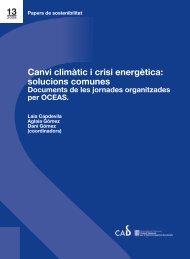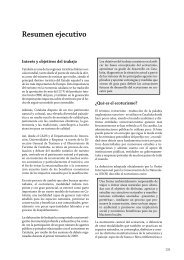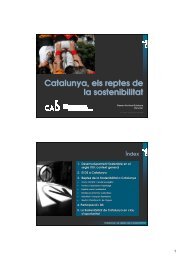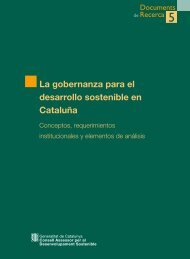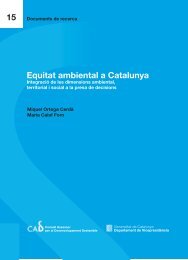Estratègies per al desenvolupament sostenible - Generalitat de ...
Estratègies per al desenvolupament sostenible - Generalitat de ...
Estratègies per al desenvolupament sostenible - Generalitat de ...
Create successful ePaper yourself
Turn your PDF publications into a flip-book with our unique Google optimized e-Paper software.
may thus result in less expenditure on the part of the government and in a moreefficient use of resources. However, the distribution of resources is likely to change.The introduction of an industri<strong>al</strong> pollution emissions charge means that companieshave to pay for their use of the assimilative capacity of the environment whereas,previously, they accessed this at no charge. For this reason, finance may be nee<strong>de</strong>din the short term to help certain groups to adjust.At the nation<strong>al</strong> level, there are three basic approaches to market mechanisms: (1)remove existing financi<strong>al</strong> mechanisms that work against sustainable <strong>de</strong>velopment,such as energy subsidies; (2) adapt existing market mechanisms; (3) introduce newfinanci<strong>al</strong> mechanisms that intern<strong>al</strong>ize environment<strong>al</strong> or soci<strong>al</strong> extern<strong>al</strong>ities.The three types of measure will have winners and losers and their impact an<strong>de</strong>ffectiveness will vary <strong>de</strong>pending on the nature of the sector, or the environment<strong>al</strong>or soci<strong>al</strong> issue being addressed. For this reason, a study of their potenti<strong>al</strong> impactis nee<strong>de</strong>d first.Removing <strong>per</strong>verse incentives. For a number of reasons, key productive inputs suchas energy, water and pestici<strong>de</strong>s are often priced below private margin<strong>al</strong> cost. Thismay be because of government subsidies or price controls which aim to encourageindustri<strong>al</strong> productive activity. Alternatively, the ration<strong>al</strong>e may be to protect the interestsof low-income groups or to provi<strong>de</strong> services consi<strong>de</strong>red to have public he<strong>al</strong>th benefits.In some cases, it may be consi<strong>de</strong>red administratively simpler to have less precisecharging policies. The remov<strong>al</strong> of distorting subsidies has a number of positive effects.It frees up financi<strong>al</strong> resources which can then be <strong>de</strong>ployed in activities more conduciveto sustainable <strong>de</strong>velopment. It improves the environment. It encourages economicefficiency. And it is likely to improve income distribution. The OECD 16 , drawing fromcase studies in sever<strong>al</strong> member countries, has shown how the remov<strong>al</strong> of subsidiesin agriculture, energy, industri<strong>al</strong> activities and transport can lead to win–win situations.Market mechanisms may pen<strong>al</strong>ize companies or individu<strong>al</strong>s for adverse environment<strong>al</strong>or soci<strong>al</strong> impacts. Or they may make them pay for natur<strong>al</strong> resource use. Or they mayreward them for providing environment<strong>al</strong> or soci<strong>al</strong> services. The main issues associatedwith such mechanisms are:Determining the appropriate level of the charge or payment. Early schemes wereintroduced more as revenue-raising instruments than behaviour-changing approaches.16 OECD (1998), Improving the Environment Reducing Subsidies, OECD, Paris 175




